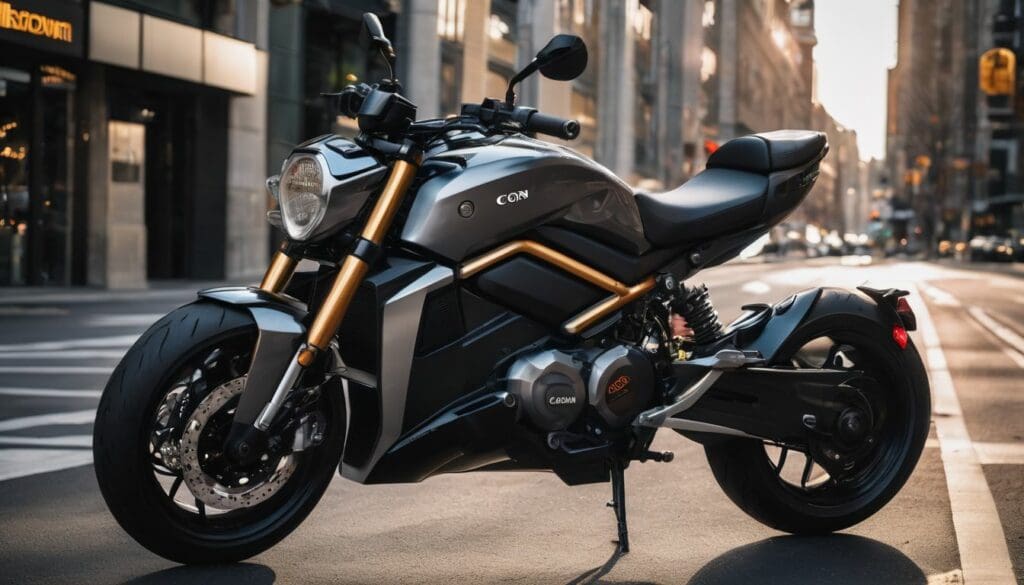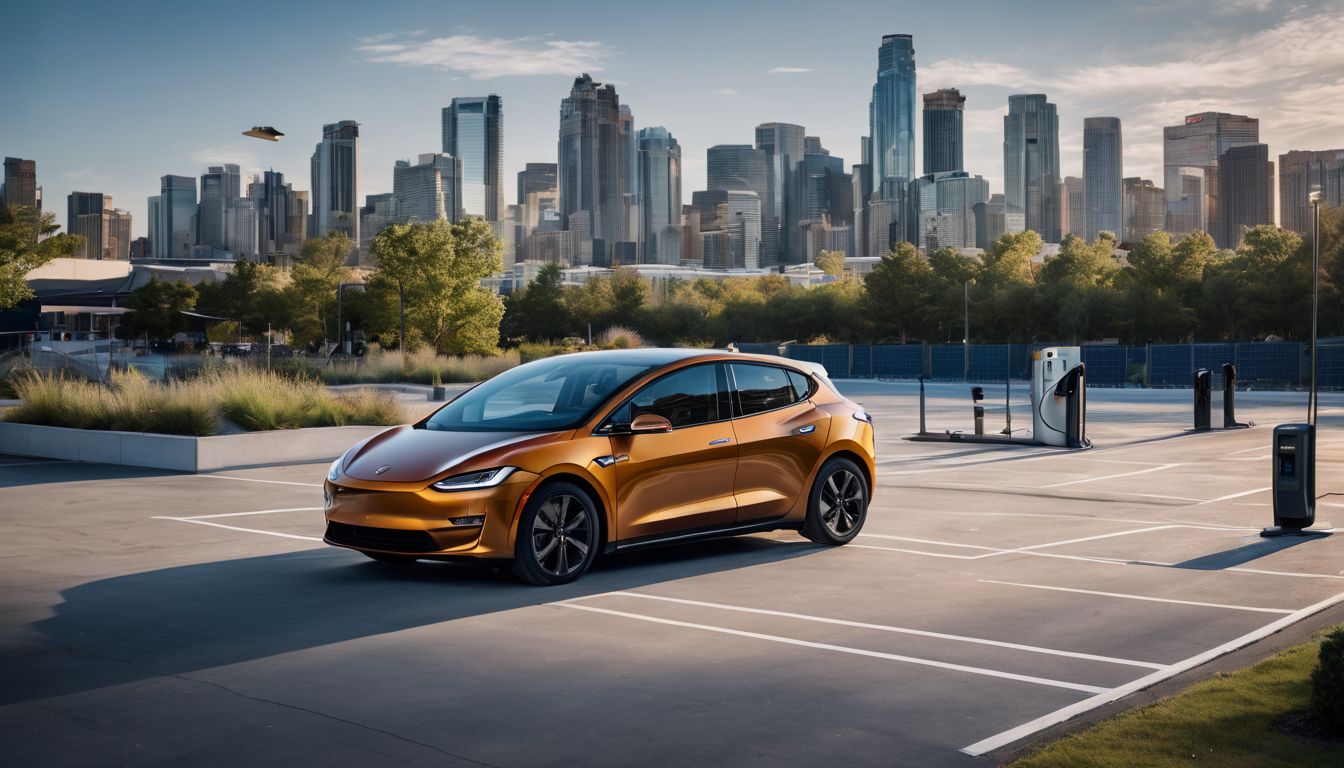We all yearn for that breath of fresh air and the lush greenery of our cities, yet it’s hard to ignore the persistent hum and fumes from traditional motorbikes that seem to linger in our urban landscapes.
Much like yourself, we’ve been on a quest — eager to find that perfect balance where we can indulge in our passion for hitting the roads without leaving a trail of emissions behind.
Sure enough, there’s promising news on the horizon: have you heard? Forecasts are showing us an inspiring uptick with electric motorcycle sales expected to surge by 35% over the next half-decade.
In this exploration, let’s embark on a journey together to uncover how these nifty two-wheelers might just be our allies in striving towards more sustainable modes of transport. So, pop your helmet on and join us as we gear up to enhance your understanding about environmentally-friendly biking adventures!
Key Takeaways
- Sales of electric motorcycles are expected to skyrocket by 35% in the next five years, showing a strong shift towards greener transport.
- Innovative designs in eco – friendly motorbikes use sustainable materials like bamboo and recycled plastics, reducing environmental impact from production.
- Strict emissions regulations push manufacturers to create low – emission vehicles with cleaner technologies such as electric and hybrid engines.
- Technological advancements improve battery life and performance in electric motorcycles, enhancing their appeal as an alternative to fossil fuel-powered bikes.
- Growing infrastructure for electric vehicles, including charging stations and dedicated lanes, is crucial for the widespread adoption of sustainable motorcycles.
How Motorcycles Fit into a Sustainable Future
Motorcycles have a significant role to play in sustainable transportation, especially as urban mobility increases. With the evolution of motorcycles and growing environmental awareness, there is a pressing need to address emissions and pollution from traditional bikes.
This section will explore how motorcycles can pivot towards more eco-friendly solutions for the future.
Historical context and current environmental challenges
From their invention, motorcycles have shaped urban mobility with a smaller footprint than cars. They’ve weaved through busy city streets and breathed life into remote areas. However, these two-wheeled machines come with environmental challenges.
Exhaust fumes from motorbikes add to the cocktail of pollution choking our cities. As emissions laws tighten, the pressure grows on manufacturers to find greener solutions.
We’re now at a crossroads where innovation must drive us forward towards sustainable transportation. Motorcycles are evolving with green technology, marking a new chapter for ecofriendly vehicles.
Next, let’s explore how this evolution is reshaping motorcycles and nurturing environmental awareness in the industry.
Evolution of motorcycles and environmental awareness
Motorcycles have come a long way in terms of environmental awareness. Historically, traditional motorcycles were known for their high emissions and contribution to pollution. However, the evolution of motorcycles has seen a shift towards greater environmental consciousness within the industry.
Manufacturers are now increasingly aware of the impact their products have on the environment and are actively seeking ways to reduce emissions and promote sustainability through innovative design and technology.
This awareness is evident in the development of electric motorcycles, hybrid solutions, and integration of environmentally friendly materials. The industry’s response aligns with broader efforts towards green transportation, catering to individuals who prioritise eco-friendly transport options.
Looking forward, it is imperative that this momentum continues to shape the future of motorcycling as an environmentally conscious mode of transportation.
Emissions and pollution from traditional motorcycles
As we shift our focus from the evolution of motorcycles and environmental awareness, it’s crucial to address the concerning issue of emissions and pollution stemming from traditional motorcycles.
Gas-powered motorcycles contribute significantly to air pollution and greenhouse gas emissions, impacting our environment and public health. The combustion of fossil fuels in these vehicles generates harmful pollutants such as carbon monoxide, nitrogen oxides, and particulate matter that not only contaminate the air but also pose serious health risks.
Addressing this challenge is pivotal in steering towards a more sustainable future for motorcycling.
Regulatory pressures and industry shifts
Transitioning from the harmful emissions and pollution caused by traditional motorcycles, we must now address the regulatory pressures and industry shifts that are driving change in the motorcycle sector.
As environmentally conscious individuals, it’s crucial to understand the evolving landscape of regulations aimed at reducing emissions and promoting eco-friendly transport. The industry is experiencing a shift towards embracing renewable energy sources, alternative fuels like hydrogen fuel and natural gas vehicles, as well as low-emission vehicles.
These changes are indicative of a growing demand for clean transportation solutions that align with our vision for sustainable mobility. By staying informed about these regulatory pressures and industry shifts, we can actively support the adoption of green mobility practices within the motorcycle community while championing conservation efforts.
The Electric Motorcycle: The Future of Eco-Friendly Riding
Electric motorcycles are the future of eco-friendly riding, offering benefits such as zero emissions and lower maintenance costs. To find out more about how electric motorcycles are leading the way in sustainable transport, read on.
Benefits of electric motorcycles
Electric motorcycles offer numerous benefits, contributing to eco-friendly transport and reducing emissions. They include:
- Lower Environmental Impact: Electric motorcycles produce zero emissions, reducing air pollution and environmental harm.
- Cost Efficiency: Operational costs are lower due to reduced fuel consumption and maintenance requirements.
- Quiet Operation: Electric motors run quietly, minimising noise pollution in urban and natural settings.
- Instant Torque: Electric motorcycles deliver instant torque for quick acceleration and responsive performance.
- Simplified Maintenance: With fewer moving parts, electric motorcycles typically require less maintenance compared to traditional petrol-powered models.
Comparative analysis: electric vs. gas-powered models
We’re witnessing a remarkable shift towards green transportation, and motorcycles are no exception. Diving into a comparative analysis, let’s line up electric motorcycles against their petrol-powered counterparts to see how they fare in the quest for sustainability.
| Aspect | Electric Motorcycles | Petrol-Powered Motorcycles |
|---|---|---|
| Emissions | Zero tailpipe emissions | Higher CO2 and pollutants |
| Efficiency | Higher energy conversion efficiency | Less efficient energy use |
| Noise Pollution | Significantly quieter operation | Noisier engines |
| Running Costs | Lower due to fewer moving parts | Higher fuel and maintenance costs |
| Fuel Dependency | Reduced reliance on fossil fuels | High dependency on petrol |
| Performance | Instant torque and smooth acceleration | Power delivery depends on RPM |
| Infrastructure | Growing network of charging stations | Well-established fuel stations |
| Innovation Potential | High, with rapid advancements in battery technology | Incremental improvements, mature technology |
| Longevity | Longer lifespan with fewer mechanical issues | Engine wear and tear over time |
| Government Incentives | Many regions offer incentives for electric vehicle purchase | Fewer incentives, some places have penalties for emissions |
As we move beyond emissions and maintenance, let’s delve into the creative world of design that awaits in the next section.
Technological innovations and advancements
Technological innovations and advancements in electric motorcycles have led to significant improvements in performance and range. Battery technology has rapidly evolved, resulting in longer-lasting and more efficient power sources for electric bikes.
Additionally, advancements in motor design and energy management systems have enhanced the overall riding experience, making electric motorcycles a viable alternative to traditional gas-powered models.
Furthermore, the integration of smart technologies such as regenerative braking systems and wireless connectivity has further boosted the appeal of electric motorcycles. These innovations not only contribute to reduced emissions but also provide riders with a seamless and intuitive riding experience.
Alternative power sources and hybrid solutions
After examining the technological innovations and advancements in electric motorcycles, it becomes evident that alternative power sources and hybrid solutions are essential for achieving sustainable transportation.
With a continued focus on eco-friendly transport, low-emission vehicles, and incorporating innovative designs for fuel efficiency, the integration of alternative power sources and hybrid solutions offers a promising future for environmentally conscious individuals supporting conservation efforts.
These emerging technologies not only address the pressing environmental challenges but also pave the way for a more sustainable motorcycling future. By exploring alternative power sources such as solar or wind energy alongside hybrid solutions that combine electric propulsion with traditional combustion engines, we can strive towards reducing emissions while maintaining the thrill of motorcycle riding.
Innovative Designs and Eco-Friendly Features
Innovative designs and eco-friendly features play a crucial role in the future of sustainable motorcycling. From the use of environmentally friendly materials to sustainable manufacturing processes, these elements are essential for creating fuel-efficient and eco-friendly motorcycles.
Use of environmentally friendly materials
Manufacturers are increasingly using environmentally friendly materials in motorcycle production. Sustainable alternatives such as bamboo, recycled plastics, and organic fabrics are becoming popular choices for components like bodywork, seat covers, and accessories.
Additionally, innovative designs incorporate lightweight yet durable materials to maximise fuel efficiency without compromising safety or performance.
Companies are committed to sustainable manufacturing processes that minimise waste and reduce environmental impact. By incorporating eco-friendly materials into their products, manufacturers aim to create motorcycles that align with the values of environmentally conscious individuals who support conservation and low-emission vehicles.
Sustainable manufacturing processes
Manufacturers implement sustainable manufacturing processes to reduce environmental impact. Eco-friendly materials like recycled plastics and biodegradable components are increasingly used in motorcycle production.
Manufacturers also optimise energy usage and minimise waste during the manufacturing process, contributing to lower emissions and resource conservation.
These initiatives align with our vision for a greener future of motorcycling, making eco-conscious choices more accessible for environmentally aware individuals. Sustainable manufacturing processes are crucial in the shift towards low-emission vehicles and support our commitment to conservation efforts.
Integration of sustainable materials and practices
Motorcycle manufacturers are increasingly integrating sustainable materials and practices into the design and production of their bikes. By using eco-friendly materials like bamboo, recycled plastic, and biodegradable components, they are reducing the environmental impact of motorcycle manufacturing processes.
These efforts align with the growing demand for low-emission vehicles among environmentally conscious individuals who support conservation and environmental protection.
Manufacturers are also exploring innovative ways to incorporate sustainable practices in their supply chain management, aiming to minimise waste generation and energy consumption during production.
Innovative designs for fuel efficiency
Manufacturers are exploring innovative designs to improve fuel efficiency in motorcycles. These include aerodynamic body shapes, streamlined fairings, and lighter materials for reduced drag and improved performance.
Additionally, advancements in engine technology such as variable valve timing and electronic fuel injection systems are enhancing overall fuel economy.
Furthermore, the incorporation of regenerative braking systems and automatic start-stop features further contribute to reducing energy consumption and emissions. These continuous efforts aim to create motorcycles that not only deliver exceptional performance but also minimise their environmental impact by maximising fuel efficiency.
Challenges and Future Perspectives
As we look towards the future, there are technical challenges and research hurdles that need to be addressed in order to make electric motorcycles more accessible and efficient. Additionally, policy and infrastructure development will play a critical role in the widespread adoption of eco-friendly motorcycles, while public perception and acceptance also need to shift for a truly sustainable motorcycling future.
Technical limitations and research challenges
Developing eco-friendly motorcycles comes with its share of technical limitations and research challenges. One major obstacle is the limited range of electric motorcycles compared to traditional gas-powered models.
Overcoming this hurdle requires advancements in battery technology, leading to longer-lasting and more efficient power sources. Additionally, the development of charging infrastructure needs to keep pace with the growing popularity of electric vehicles.
Research challenges also encompass enhancing safety features without sacrificing environmental benefits. Innovations in lightweight yet durable materials are crucial for maintaining structural integrity while reducing energy consumption during production and operation.
Policy and infrastructure development
Transitioning from technical limitations and research challenges to policy and infrastructure development, we recognize the crucial role of government regulations and urban planning in fostering a greener transportation ecosystem.
Encouraging low-emission vehicle adoption through tax incentives, subsidies, and infrastructure investments is imperative for shaping a sustainable future. Additionally, enhancing the network of charging stations and dedicated bike lanes can significantly boost the appeal and convenience of eco-friendly motorcycles, paving the way towards widespread public acceptance.
Innovative policies that prioritize sustainability along with progressive urban planning initiatives will ultimately drive positive change. As environmentally conscious individuals, supporting conservation and low-emission vehicles becomes an integral part of advocating for proactive governmental measures to propel green transportation forward.
Public perception and adoption rates
Public perception of eco-friendly motorcycles is steadily shifting towards a more positive outlook due to increasing environmental awareness. As low-emission vehicles gain traction, individuals are embracing the idea of sustainable transportation options.
Adoption rates are expected to rise with the growing availability and diversity of eco-friendly motorcycle models on the market. The appeal of stylish designs and innovative features that promote fuel efficiency and sustainability is drawing attention from environmentally conscious riders, contributing to a promising future for green transportation solutions.
Society’s acceptance of electric motorcycles as a viable alternative for traditional petrol-powered models reflects an evolving mindset towards prioritising environmental conservation.
Vision for a sustainable motorcycling future
We envision a future where motorcycles play a pivotal role in eco-friendly transportation, contributing to lower emissions and reduced environmental impact. Our vision encompasses widespread adoption of electric motorcycles, featuring innovative designs and sustainable materials that prioritise fuel efficiency and eco-friendliness.
We are committed to overcoming technical limitations through research and development, while advocating for policy changes and infrastructure developments to support the growth of low-emission vehicles.
Our goal is to shape a future where motorcycling aligns with conservation efforts, promoting environmentally conscious choices within the transport industry.
Conclusion
In conclusion, electric motorcycles offer an eco-friendly alternative to traditional gas-powered models. These bikes are not only environmentally friendly but also boast advanced technological features.
With sustainable materials and innovative designs, the future of motorcycles in green transportation looks promising. As we tackle challenges such as research limitations and policy development, a sustainable motorcycling future is within reach.
FAQs
1. What role do motorcycles play in green transportation?
Motorcycles are becoming key players in eco-friendly transport as they evolve into low-emission vehicles, contributing to cleaner and greener travel options.
2. How will motorcycles change to be more environmentally friendly?
In the future, motorcycles will likely embrace electric power sources and innovative technologies to reduce their environmental impact as part of green transportation initiatives.
3. Can motorcycles really make a difference in reducing pollution?
Yes, by switching to electric models and other eco-friendly designs, motorcycles can significantly lower emissions and become a sustainable choice for everyday commuting.
4. Will we see more motorcycles on the road as part of green transportation plans?
Absolutely! As cities focus on reducing carbon footprints, expect an increase in motorcycle use due to their potential as efficient low-emission vehicles within green transport systems.





